It’s that time of year again – the time when some RVers who travel in colder locations need to make a few modifications to ensure that they’ll stay warm and their RV will remain healthy through the winter. RVs have lots of components that require protection from the cold, and, depending on how and where you use your RV, RV tank heating pads may be the ticket to keeping your holding tanks protected this winter.
So, today’s post is all about RV tank heating pads. We’ll discuss what they are and whether you even need them for your particular RV or for your style of travel. We’ll also get into what to look for if you’re shopping for RV tank heating pads, how to install them, how to use them, and we’ll toss out five of the best tank heating pad options out there (some 12V options for boondockers and some 120V options for those of you who hook up to shore power during your winter travels).
Let’s get to it! It’s getting cold out there!
- 1) How Do You Heat an RV Holding Tank?
- 2) What Are RV Tank Heating Pads?
- 3) What to Think About When Considering RV Tank Heating Pads
- 4) When Should I Turn On My RV Tank Heating Pads?
- 5) Can I Run My RV Tank Heating Pads While Driving?
- 6) How Many Amps Do RV Tank Heaters Draw?
- 7) How Can I Protect the Rest of My RV Plumbing System from Freezing During Winter Use?
- 8) How Do You Install RV Tank Heaters?
-
9)
5 of the Best RV Tank Heating Pads for Your RV
- 9.1) Facon 12″ x 18″ RV Holding Tank Heater Pad (2-pack) with Automatic Thermostat Control
- 9.2) Facon 7-1/4″x25″ RV Water Holding Tank Heater Pad with Automatic Thermostat Control
- 9.3) Facon 8.0″x 25″ RV Tank Heater Pad with Automatic Thermostat Control (Pack of 1)
- 9.4) RV Tank Heater Pad 8″ x 25″ (20 to 40 Gallons) 120V (1 Pad)
- 9.5) RV Holding Tank Heater Pad – Up to 50 Gallons Fresh Water 120V 12″ x 18″ Holding Tank Heating Pad with Constant Temperature Heating Plate (Pack of 2)
- 10) Should I Heat My RV Holding Tanks When They’re Empty?
- 11) Are RV Tank Heaters Worth It?
How Do You Heat an RV Holding Tank?
Many RVers brave the cold to enjoy winter camping, and there’s no reason not to use your rig in winter – as long as you know how to do so comfortably and with reasonable protection for your RV. Some folks enjoy taking their rigs to extremely cold and snowy areas to ski or snowboard, while others travel to visit loved ones over the holidays. Still others are static in cold temperatures and need to be prepared to protect components of their RV from freezing.
When we custom-ordered our Newmar Mountain Aire in 2005, we checked the box next to “Heat Pads for Holding Tanks” on the option sheet. Even though we’re snowbirds who chase good weather, we still occasionally spend time in very cold climates… like the time we were winter camping in Zion National Park in February and accidentally froze our hydraulic jacks to the ground!
Our tank heat pads don’t get used very often, but we still think that $239 option was money well spent back in 2005. Although maybe we should have checked the “Heat Pads for Hydraulic Jacks” option, too! ????
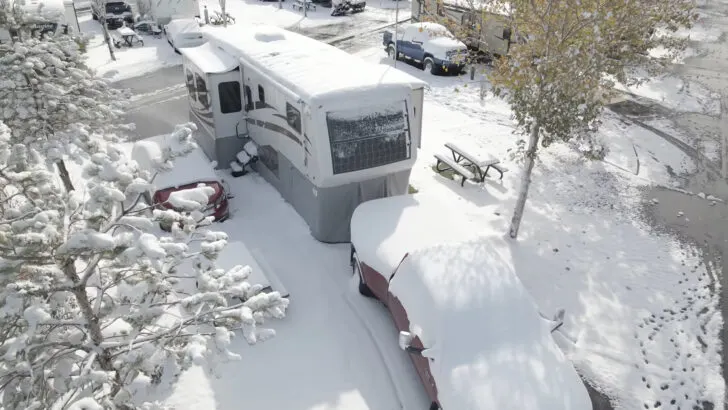
Some RVers spend time in cold winter climates and are careful to take a variety of measures to protect their RV. (Photo credit: Tom and Caitlin Morton, Mortons on the Move.)
Heating an RV holding tank sounds like it might be complicated, but it’s not as tall an order as you may think. Aftermarket RV tank heating pads have come on the market in recent years and are now widely available in both 12V (DC) and 120V (AC) models. There are several options available to keep your tank contents from freezing during winter camping and to keep your tanks from being damaged by exposure to the cold.
RV tank heaters now come standard on some newer RVs. Even those with enclosed basements, like ours, will benefit by ensuring tanks don’t freeze even in the coldest weather. But if your rig doesn’t have tank heat pads and the holding tanks are exposed, you can install your own tank heaters with the same results.
RV holding tanks that are exposed to the elements can crack during very cold temperatures, and when you’re winter camping, you certainly don’t want your fresh water freezing.
If you have an RV that leaves your holding tanks exposed, and you RV in freezing conditions even occasionally, RV tank heating pads are worth considering.
What Are RV Tank Heating Pads?
Have you ever had a backache and grabbed a heating pad, plugged it into a power outlet, set it along your back, and turned it on to give you some extra warmth in that area?
An RV tank heating pad works in essentially the same way. While there are various types of tank heating pads available, they all work by being affixed to your holding tanks (or other components such as pipes, elbows, and even gate valves) with a peel-and-stick type of adhesive. They’re then connected to the electrical power of your RV, providing warmth to the tanks or components when they’re turned on.
Some RV tank heating pads even have thermostats that detect when the temperature falls below a preset level at which point the tank heater turns on automatically.
What to Think About When Considering RV Tank Heating Pads
When considering the possibility of installing RV tank heating pads, there are a number of questions to answer, not the least of which is whether you even need them in the first place.
Does My RV Need Tank Heaters?
Before we delve into the things to consider when shopping for tank heaters, let’s first establish that many RVers have no need for them at all. Class A motorhomes, for example, (and particularly diesel pushers like ours), often have holding tanks that are installed in fully-enclosed basements that add insulation. These areas are heated via an output from the onboard furnace, so tank heating pads are far less likely to be needed, depending on how and where you use your RV.
Even though our tanks are in an enclosed basement, we opted for tank heat pads for a couple of reasons: 1) We usually prefer to heat with either an electric space heater or two (when hooked up), or our portable propane heater (when boondocking), which is much quieter and saves a ton of propane compared to our furnace. But those methods don’t pump heat into the basement. 2) It was a modestly-priced option that we felt might be tricky to install later due to the enclosed tank installation.
Some RVers simply choose never to travel in areas subject to very cold temperatures, so their RVs won’t need heated holding tanks either.
But many RVs have exposed holding tanks. Some, especially smaller rigs like the Class B vans, are too small for holding tanks to be enclosed in a heated space, so they’re generally installed under the body of the van, exposed to the elements.
Travel trailers are the same, often having only a thin layer of coroplast to “seal” the bottom of the trailer.
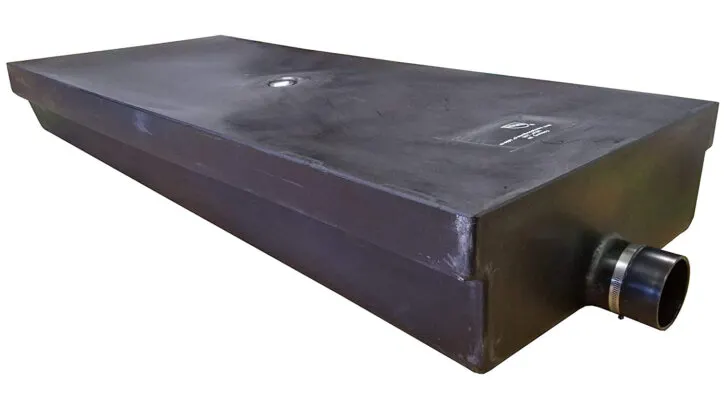
Some RV holding tanks are mounted to the underbelly of the RV and are exposed to the elements, unprotected.
RVers with exposed holding tanks who tend to spend time in areas where temperatures drop below freezing are the most reasonable candidates for RV tank heating pads. The good news is that exposed tanks are, by their very nature, generally easier to access and therefore great candidates for a DIY tank heat pad installation project.
If your RV and your RV lifestyle leave your holding tanks vulnerable to freezing temperatures, here are some of the things you’ll want to consider when shopping for your tank heaters:
How Will You Power Your RV Tank Heating Pads?
First, you’ll need to consider how you intend to power your heating pads. Tank heaters require electricity. They’re installed on the bottom of the holding tank and wired into your RV’s electric system. A switch is usually installed on the interior of the RV, enabling you to turn the heaters on and off as needed.
If you intend to be hooked up to shore power all the while you’re winter camping, or if you intend to use a generator, you can opt for 120V (AC) tank heating pads, and the electricity will be supplied by the shore power/generator power to which you’ve connected.
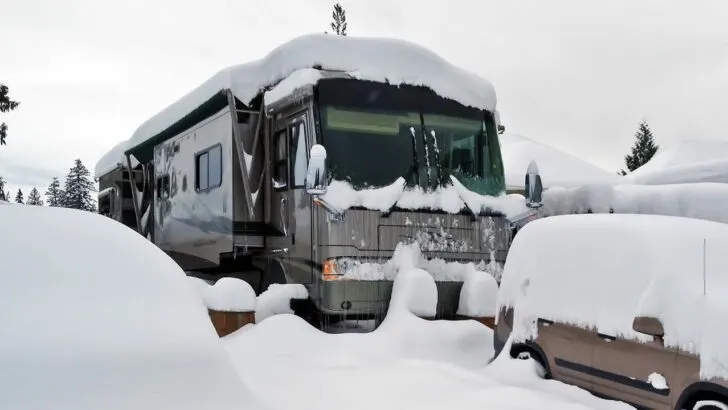
If your RV is connected to shore power during your winter camping, you can opt for 120V(AC) tank heaters.
If you tend to boondock at all in freezing weather and you don’t want to (or can’t) run a generator for extended periods, you’ll want to opt for a 12V (DC) version so that power can be supplied by your rig’s house battery bank. In this case, you’ll also want to be sure to have access to sufficient battery power to add heating pads to your power requirements.
We’ll cover those power requirements in further detail in just a moment.
How Big Are Your Holding Tanks?
You’ll also need to check the size of your holding tanks and purchase your tank heaters accordingly.
Holding tank heating pads come in a variety of sizes to accommodate the various tank sizes. Knowing the size of the tank or tanks you want to heat is important as you head into shopping mode.
How Many Tanks Do You Need to Heat?
Next, you’ll want to decide which tanks you’ll be heating. Some RVers choose to only heat the fresh water tank so that their fresh water doesn’t freeze. Others heat all three holding tanks, fresh water, gray water, and black water in an effort to protect the integrity of the tanks themselves while also continuing to use them during cold weather camping.
Do You Want the Power Switch for the Tank Pads Inside Your RV?
Some RV tank heating pad systems come with a little control panel to which the tank heaters are wired. The control panel is mounted inside your RV giving you control of the tank heaters from inside.
Not all tank heaters are so equipped, so if you want a control panel provided to you with your tank heaters, you’ll want to make sure that’s included with the system you buy.
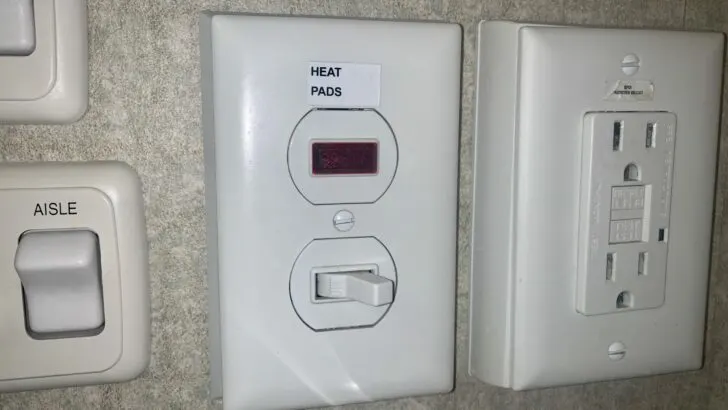
The holding tank heat pad on/off switch is conveniently located inside our RV. A red light indicates when they’re on.
What is Your Budget?
And as always, budget is a concern for most of us whenever we make an upgrade of any kind to our RVs.
There are some very expensive tank heating systems out there with thermostats and wall monitors and controls. But there are also many reasonably inexpensive heating pads with similar amenities that will do the job you need them to do.
Check your budget, and plan accordingly.
When Should I Turn On My RV Tank Heating Pads?
Unless you have an RV tank heating pad system with a thermostat that monitors temperatures and automatically turns on the heating pads when freezing temps occur, you’ll need to monitor the weather for this situation.
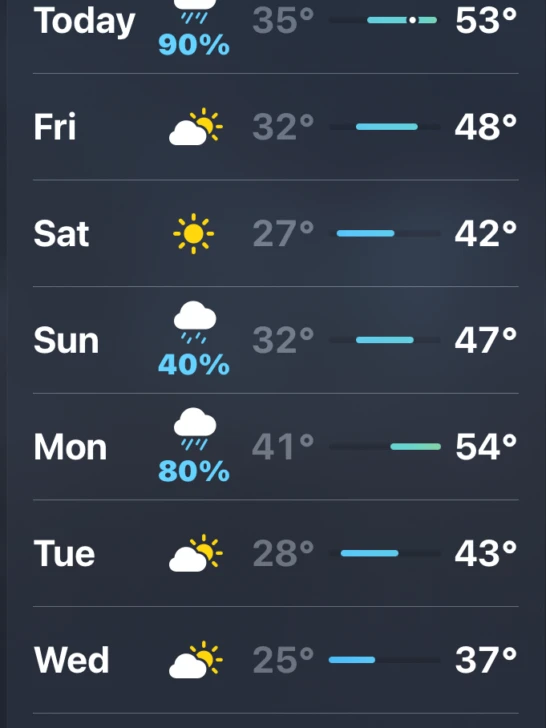
If the weather forecast indicates that ambient temperatures are approaching freezing and are likely to remain there (or lower) for several days, you’ll want to prepare to turn on your tank heating pads.
32 degrees Fahrenheit or 0 degrees Celsius indicates freezing, so if you’re using your RV anywhere near these low temps, check the forecast and prepare accordingly.
Be aware that if you’re camping in a location where you have difficulty obtaining a cell signal for weather forecasts, you’ll need to be aware ahead of your travel to that location so that you can be prepared to turn on your tank heaters as needed.
Don’t turn your heating pads on if your holding tanks are empty. There should be liquid in the tank to use a tank heating pad. If your RV is parked and your tanks are empty, don’t use holding tank heaters.
Remember to turn OFF your RV tank heaters when the ambient temperature rises.
Can I Run My RV Tank Heating Pads While Driving?
You can, and you may want to consider doing so – depending on conditions.
Most modern RV propane furnaces distribute some heat output to the floor under which the holding tanks sit. Given the right conditions, this alone may be sufficient to keep tanks from freezing in cold temperatures for shorter durations of time.
But if you drive your RV in areas where temperatures are below freezing, the combination of wind and below-freezing ambient temps can cause tank freezing. While you may not want to keep your propane furnace on while you drive to keep the tanks from freezing, your 12V RV tank heating pads could come in very handy in this scenario.
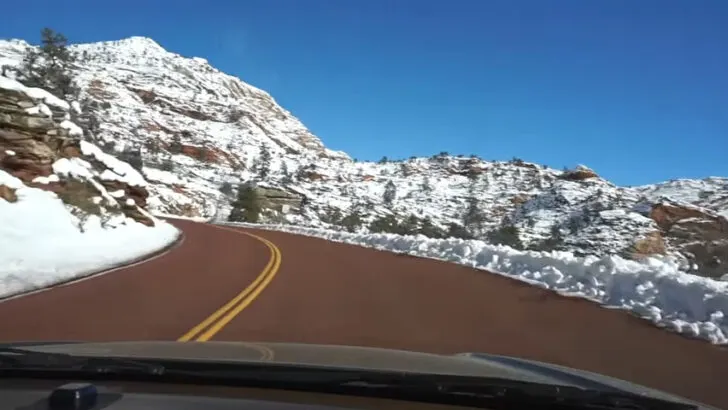
12V RV tank heating pads can come in very handy when you’re driving in extremely cold temperatures.
When you’re traveling in below-freezing temps, you can either use your heating pads on all three tanks, or you can put a little RV antifreeze in your gray and black tanks, turn your fresh water tank’s heating pad on, and keep your RV’s plumbing system working well as you travel.
How Many Amps Do RV Tank Heaters Draw?
This one’s tough to answer in general, because the amperage drawn by your RV tank heating pads will be directly correlated to the size of the tank heaters you install.
Most tank sizes run anywhere between 20 and 75 gallons, so the size of tank heaters varies that widely, and the amount of amperage they draw varies widely as well.
Most tank heaters draw somewhere between 4 and 12 amps of power when they’re turned on. The amount of amperage drawn by your particular heating pads is important to know because you don’t want to drain your battery bank inadvertently. Your tank heaters will draw energy all the while they’re in use, so the size and overall condition of your battery bank will be a factor in how long you can leave them on if you’re not plugged into shore power.
If you’re boondocking in winter, keeping your batteries as well maintained and as well charged as possible will be helpful in sustaining your ability to protect your holding tanks by running the heating pads. If you look at the information in the description of the tank heaters you’re considering buying, (or if you look at the literature that accompanied the RV tank heating pads you own), you should be able to determine how many amps are used by your tank heaters. Dividing your house battery bank’s amp-hour rating by the number of amps used by your tank heater(s) will give you an idea of how long you can run your tank heater(s) without draining your battery bank.
If necessary, camp where you have access to shore power when you run into extremely cold temperatures.
How Can I Protect the Rest of My RV Plumbing System from Freezing During Winter Use?
If you’re stationary in cold temps, skirting can be helpful in protecting your plumbing system to some degree. You can also add some antifreeze to your black and/or gray tanks.
You can even camp in freezing temperatures in a fully winterized RV. We’ve heard of folks who winterize their RV in early November or so, and travel and boondock all winter despite having a fully winterized rig. They use a little RV antifreeze to flush the toilet, catch their gray water in a pan in the sink and dispose of it when they can, and carry drinking water aboard for cooking, brushing teeth, washing dishes, bathing, and of course drinking.
But there are other ways to protect your RV’s plumbing system if you want to continue to use your rig in sub-freezing temperatures.
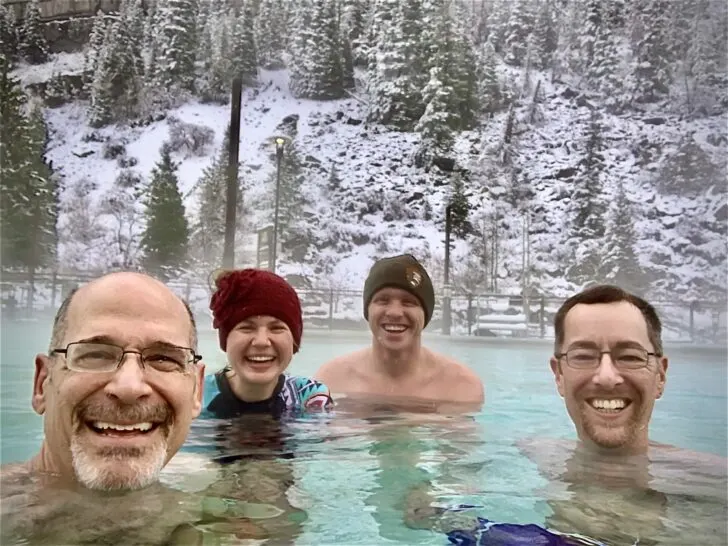
There are lots of activities that make cold-weather RVing worthwhile. Shout out to our dear friends Heath & Alyssa Padgett with whom we enjoyed some awesome winter hot springs fun!
Pipe & Elbow Heaters
There are tiny heaters on the market that are designed specifically for RV pipes and for the elbows of RV pipes. They work in a similar fashion to the larger tank heating pads, but because they’re much smaller they draw less than a few amps per heater.
Pipe and elbow heaters are designed to be used mainly for 12V (DC) power. But even if you’re connected to shore power and your large tank heaters are running on 120V (AC) power, you can still run your little pipe and elbow heaters on 12V (DC) power.
Pipe and elbow heaters can be used with or without full-size tank heaters. Like the tank heaters, they’ll need to be run to your RV’s electrical system, but they’ll use far less power and may be sufficient to protect your pipes, depending on ambient conditions.
This is an example of elbow pipe heaters:
- [Exclusive Technology] Facon’s world-famous Tank Heater Pads. Heater Pads are Designed and Engineered to protect RV holding tanks, pipes and steps...
- [Elbow Pipe Heater Pad] Simply turn "ON" the power switch when the outside temperature is near to freezing. Turn "OFF" the switch when the outside...
Gate Valve Heaters
Gate valve heaters are another option for RVers who travel in cold temperatures. When you camp in conditions like these, the gate valves that need to be opened in order to dump your gray and black tanks can freeze. In fact, they probably will freeze, especially if they’re exposed rather than inside a basement compartment.
If you’re a deep cold weather camper, you need to be able to open your gate valves when it’s time to dump, so gate valve heaters might be for you.
These work a bit differently from the other heaters we’ve discussed, however. Gate valve heaters are designed to be used in short, intense spurts to heat up the heavy plastic around the gate valves to thaw them when they’re frozen. This means that the gate valve heaters are entirely separate from any other heating pads you may be using, and so they need to be independently controlled. They can’t be on the same on/off switch as your tank and/or pipe and elbow heaters.
Gate valve heaters are used only when needed, for 5-10 minutes or so, until the gate valve is capable of being opened. Once the gate valve is thawed, you’d turn off the gate valve heater, evacuate your tanks, close your gate valves, and not use the gate valve heater again until/unless your gate valves need thawing again.
This is an example of gate valve heaters that wrap around three sides of the valve (and again, must be independently switched). These have about a 2 amp draw:
- [Exclusive Technology] Facon’s world-famous Tank Heater Pads. Heater Pads are Designed and Engineered to protect RV holding tanks, gates, pipes and...
- [Gate Valve Heater Pad] Gate Valves are notorious for freezing up in cold weather, even if the Tanks and Drainage pipes are heated. Simply turn "ON"...
These types of items are generally reserved for folks who intentionally camp in very cold weather for an extended period of time.
How Do You Install RV Tank Heaters?
The installation of RV tank heating pads is not usually difficult. In general, you’ll follow the steps below along with any instructions that come with the specific tank heaters that you purchase.
- As always, check your installation instructions and note where on the tank the manufacturer recommends heating pads to be installed.
- Thoroughly clean the area of the holding tank(s) where the pad(s) will be installed.
- Remove paper backing from application adhesive. Use caution here – the adhesive is likely to be very sticky and may be difficult or impossible to re-position once adhered to the tank.
- Press the adhesive-side portion of the pad onto the holding tank. Begin at one end, moving slowly in one direction applying even pressure as you cover the tank.
- Engage (turn off) your RV battery disconnect switch or remove the negative cable to your RV’s house battery bank.
- Follow the provided instructions to connect the power wires of the heating pad to your power source.
5 of the Best RV Tank Heating Pads for Your RV
Following are five of the best RV tank heating pads we’ve found available. We’ll start with a couple of 12V (DC) systems, followed by a few 120V (AC) systems for RVers whose winter camping allows them to be connected to shore power.
Facon 12″ x 18″ RV Holding Tank Heater Pad (2-pack) with Automatic Thermostat Control
Facon is a name you’ll see frequently associated with RV tank heating pads. They offer several different types and sizes of tank heaters for both 12V(DC) and 120V(AC) use. Reviews for Facon heaters tend to be very good, and this 2-pack of 12” x 18” 12V(DC) pads is no exception.
These tank heaters can heat holding tanks up to 50 gallons in size and offer automatic thermostat control, so you can turn on the heaters when the ambient temperature is falling near freezing and simply leave it on until the ambient temp rises and remains above freezing. The thermostat will turn the tank heaters on and off automatically as needed.
The foam insulation pad is designed with self-stick adhesive for easy mounting to a clean holding tank. Wiring to your 12V(DC) system is simple with two wires.
- [✅Exclusive Technology] Facon’s world-famous Tank Heater Pads. Heater Pads are Designed and Engineered to protect RV holding tanks, pipes and...
- [✅Thermostat Controlled] Simply turn "ON" the power switch when the outside temperature is near to freezing. The heat will transfer to the tank...
Facon 7-1/4″x25″ RV Water Holding Tank Heater Pad with Automatic Thermostat Control
This Facon tank heater is very similar to the product above, though it’s made for a tank of a different shape. These 25”x 7.25” heating pads are obviously for longer, more narrow tanks. Note also that this price appears to be for a single pad.
This pad will heat up to a 50-gallon holding tank and offers the benefit of automatic thermostatic control.
- [✅Exclusive Technology] Facon’s world-famous Tank Heater Pads. Heater Pads are Designed and Engineered to protect RV holding tanks, pipes and...
- [✅Thermostat Controlled] Simply turn "ON" the power switch when the outside temperature is near to freezing. The heat will transfer to the tank...
Facon 8.0″x 25″ RV Tank Heater Pad with Automatic Thermostat Control (Pack of 1)
This pad is essentially the 120V(AC) version of the pad noted directly above it. At 8” x 25”, this pad fits narrow rectangular tanks up to 50 gallons and offers automatic thermostatic control. The price shown is for a single pad.
Remember that 120V(AC) pads are specifically intended for rigs that will be plugged into shore power.
- [✅Exclusive Technology] Facon’s world-famous Tank Heater Pads. Heater Pads are Designed and Engineered to protect RV holding tanks, pipes and...
- [✅Thermostat Controlled] Simply turn "ON" the 120V power switch when the outside temperature is near to freezing. The heat will transfer to the tank...
RV Tank Heater Pad 8″ x 25″ (20 to 40 Gallons) 120V (1 Pad)
Also a 120V(AC) pad, this RV tank heater pad is intended for smaller (20-40 gallon) holding tanks that are long and narrow.
For rigs that will be plugged into 120V shore power.
- Peel and stick adhesive back attaches easily to most tanks
- Activates when water temps drop below 45F(5C) and heats to 68F(20C)
RV Holding Tank Heater Pad – Up to 50 Gallons Fresh Water 120V 12″ x 18″ Holding Tank Heating Pad with Constant Temperature Heating Plate (Pack of 2)
This is a two-pack of heating pads, 12″ x 18″ each, powered by 120V(AC). However, these heaters are different in that they’re metal plates that aren’t flexible like the rest of the pads noted above. We’re including them in case someone has a specific need or desire for rigid metal heat plates.
With a two-year warranty, these plates are said to be capable of handling ambient temperatures to -20 degrees Fahrenheit while keeping the water inside the tank above freezing. These heating plates don’t appear to have a thermostat – directions state to unplug the pad when the ambient temp is above 40 degrees Fahrenheit or when the tank is empty.
- H&G lifestyles heater Pads are Designed to protect RV water tanks from freezing. Provides water for RV, Camper, Trailer, Mobile home, Boat, Marine in...
- Using 120V voltage, 10 'long power cord, output power 45W energy saving
Speaking of empty holding tanks…
Should I Heat My RV Holding Tanks When They’re Empty?
No. You do not want to heat empty holding tanks. In fact, you should never turn on an RV tank heating pad when a holding tank is empty.
If you turn on a tank heater that is affixed to an empty holding tank, you could cause damage to the heater, the holding tank, and even the pipes connected to the tank.
So, if you use your RV and tank heaters for some cold weather camping and then later store your RV, be absolutely sure to turn OFF the heaters. When your RV is in storage your holding tanks will either be empty or carrying a bit of antifreeze, depending on your location.
Are RV Tank Heaters Worth It?
The answer to this question depends entirely on how you use your RV. If you occasionally camp in “chilly” temps, you’re unlikely to need holding tank heaters (or pipe or gate valve heaters).
If, however, you enjoy using your RV on skiing or snowboarding expeditions, or if you visit relatives or friends who live in cold winter climates over the holidays or anytime during the winter, or if you’re living stationary in an RV and it gets very cold where you live in the winter months, you could certainly benefit from having RV tank heating pads.
As with all things RV-related, much of what we need depends on our personal RV lifestyle.
Our dear friends Tom and Cait of Mortons on the Move have enjoyed lots of winter camping, and they’ve got some great advice about how to do it:
Geek Out with Us Every Week
Join our newsletter to learn about all things RV-related. Every week we offer free tips, tricks, product reviews, and more to our online community of RVers. So, whether this is your first time on the road or you’re a seasoned expert, we’d love for you to geek out with us!









Luis
Monday 8th of January 2024
Hi guys, do you have content more specific about Campervans not just RVs?
Best, Luis
TheRVgeeks
Monday 15th of January 2024
Hi Luis. Other than some info on some specific campervan style RVs, we don't have much content in that area (other than info on the systems that are common across all RVs).
Roger
Thursday 21st of September 2023
Will a tank heater pad heat a space (battery box) by installing inside box without removing paper from sticky surface ?
TheRVgeeks
Monday 25th of September 2023
Good question, Roger. It likely would... though we'd worry that the heat could, over time, dry out and make that backing paper a fire hazard. To be sure... we'd suggest reaching out to the manufacturer of the heat pad to see if they have any insight/input.
James E Holm
Saturday 18th of March 2023
can i put insulation over my 12 volt thermaHeat tank heaters? I would like to insulate and heat the underbelly of my small camping trailer
TheRVgeeks
Sunday 19th of March 2023
Hi James. Good question... and one probably best answered by whoever makes the ThermaHeat tank pads. It's likely not a problem, but it is possible that having the insulation directly in contact with the heating pads could cause too much buildup of heat, causing them to fail prematurely. If they're thermostatically controlled, they SHOULD turn themselves off.
Fred Johnson
Thursday 17th of November 2022
Need to run four 12 volt tank heaters while towing 5th wheel in very cold weather. Will the alternator on my diesel truck be able to keep charge on the house battery.
TheRVgeeks
Thursday 17th of November 2022
Hi Fred. You'd probably be OK, but it depends on a bunch of factors. Like how many amps will the 12V tank heaters pull (add up their wattage and divide by 12 to get amps)? How full will your trailer's battery be (i.e. will it be pulling amps for charging itself back up while driving)? How big is your truck's alternator... and what gauge wiring is run between the truck and trailer while towing (narrower gauge will restrict the number of amps that can flow, reducing the available amperage for the battery(ies) and tank heaters)?
Melody Phillips
Monday 17th of January 2022
How can I get rid of my poop pyramid And prevent tanks from freezing again. My RV is stationary and in winter cold temps. First time living in a RV. Please help
jim
Thursday 31st of March 2022
very simple....fill your toilet bowl FULL a few times and then let it all fall on the mound... poke it around with a short stick or blast wit with the water hose to remove old material, if you must , but drop all the water on it now and then and it never will form..water weighs alot and the weight falling spreads it out.. been doing it as a live aboard for 10 years......works great.
TheRVgeeks
Tuesday 18th of January 2022
Hi Melody. Sorry to hear about your "pyramid"! It's a tough one to deal with. You can try soaking the tank with a heavy dose of Happy Camper's Extreme (available on Amazon: https://amzn.to/3qFmY3d) or even a super heavy mixture of a water softener like Calgon or Mule Team Borax (both powders typically found in the laundry aisle in the grocery store). But if that doesn't work (which we're not hopeful it will), you may need the help of a professional to come and clean it out for you. And, once clean, be sure that you never leave the black tank valve open (fluids drain out but solids stay behind, as you've discovered)... and try to only dump the tank after it's reached 1/2 full (so there's enough force of flow draining from the tank to help pull the solids out).
As for keeping the tanks from freezing... that can vary by RV, since not all of them have heated (or very well heated/insulated) tank areas. Usually, there's a vent from the onboard furnace that blows in the tank area to keep it warm. So if you're not using your propane furnace (i.e. you're using space heaters instead), that could be a problem.
You could also improve the insulation under your RV by putting skirting on (trapping the air beneath the RV helps to keep the temperature of the tanks and basement above freezing... which will also keep you warming in the RV!). You can do it with official "skirting" products that are typically made of vinyl and snap along the bottom of your RV. Or you can improvise with mounds of snow (yes! that works!) or even bales of hay (just be aware the hay may attract other "critters").
Lastly, you can get a utility light (https://amzn.to/3fCBHpa) and a 60W incandescent bulb (https://amzn.to/3GIZFed) and place that near/under your tanks in order to keep some heat in the area and maintain it above freezing. This will only work if you have an enclosed area you can access near the tanks (on our RV, we can put it inside the water bay compartment and the heat warms the tanks, but not all RVs are laid out that way)... or if you put on/build some form of skirting to block the wind so the warmth stays in the area. Just be sure you're careful that the bulb can't melt anything or potentially start a fire.